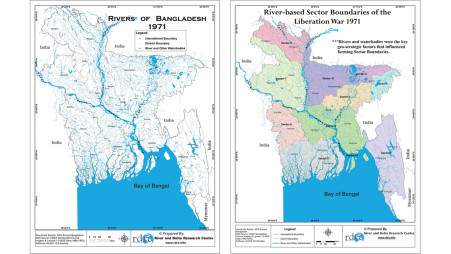During the nine-month-long struggle for the liberation, our rivers provided a lifeline and strategic channels to overwhelm and, ultimately, defeat the occupying forces

The 1971 Bangladesh Liberation War was a revolution.
And our rivers played a key role. Freedom fighters strategically used rivers to defeat the occupation forces. In a way, the rivers guided the path to the nation’s victory.
Bangladesh’s physiography characterises her as a riverine country, and this unique geographical landscape played a part in the region’s glorious history, politics and spatial dynamics.
Over time, these relentless rivers fought many wars and defeated many enemies. And in 1971, the rivers played the role of resistance to the enemy’s movement.
There are more than 700 rivers that generally flow south. The larger rivers serve as the main source of water for cultivation and as the principal arteries of commercial transportation.
The rivers in 1971, guerilla war strategy and river maps
Bangladesh is located in the fertile delta of the Ganges, Brahmaputra, and Meghna (GBM) river system. During the Liberation War, riverine Bangladesh was strategically divided into 11 sectors. The sector boundary was not political but geographical, and this planning proved to be instrumental in defeating the Pakistani forces.
The rivers such as Padma, Brahmaputra, Meghna, Jamuna, Surma, Madhumati, Muhuri, etc. played a key role in sector formation.
The River and Delta Research Centre (RDRC) conducted studies and prepared several maps that help us understand the geographical features of the rivers and water bodies of Bangladesh in 1971 and how they influenced the birth of the country.
The key features of this map have geopolitical and geostrategic implications as it highlights Bangladesh through the frame of her canals, streams and more than 1,200 rivers. 1971 can be used as the baseline or reference point to compare the current situation of rivers and water bodies.
Naval operations during the Liberation War
Operation Jackpot was carried out on 16 August 1971. After the training operation, which began on 15 May 1971, was completed, the naval commandos launched several sabotage operations in the cities of Chattogram, Chandpur, Mongla and the Narayanganj district against the combined forces of the Pakistani soldiers, Pakistan marines, Pakistan Navy SEALs, and the East Pakistan Security Forces.
During the Liberation War, the naval commandos undertook operations to sabotage military and economic assets, demoralise the Pakistani soldiers and disrupt their supply network in 21 districts and mahakumas.
In the declassified government documents, we found 73 separate naval operations undertaken by sector 10 commandos.
These operations spearheaded by the Mukti Bahini and the Indian Army proved to be so effective that, initially, the opposition forces thought this kind of operation could only be carried out by the Indian special forces. It was only much later that they learned the truth.
The simultaneous attacks on Pakistan naval shipping assets on 16 August, shattered the myth of normalcy in East Pakistan as the international media broadcasted the news. The Pakistan Army’s investigation later concluded that no one had imagined the Mukti Bahini to be capable of conducting such an operation.
During August-December 1971, the naval commandos managed to sink or damage 126 ships/coasters/ferries, while one source confirmed that at least 65 vessels of various types (15 Pakistani ships, 11 coasters, 7 gunboats, 11 barges, 2 tankers and 19 river crafts by November 1971) had been sunk.
At least 100,000 tonnes worth of supplies were sunk or deemed irrecoverable with jetties and wharves becoming disabled and channels getting blocked. This way, the valiant commandos kept East Pakistan in a state of siege without having a single naval vessel.
The operational capability of the Pakistan Navy was compromised as a result of Operation Jackpot.
Operation Hot Pants
After the operation of August 16, all commandos returned to India. After this, no pre-planned simultaneous operation was launched by the naval commandos. Instead, some groups were sent to destroy specific targets while other commandos began to hit military targets as the opportunity presented itself.
Major Jalil, Commander of Mukti Bahini Sector 9 had obtained permission from Premiere Tajuddin Ahmad to form a naval unit in August and had requested Commander M. N. Samanth for four gunboats.
In October 1971, the Kolkata Port Trust donated two patrol crafts (Ajay and Akshay) to the Mukti Bahini. The boats underwent a month-long refitting at the Khidirpur dockyard at the cost of ₹3.8 million to carry two Canadian 40×60 mm Bofors guns, two light engines and eight ground mines, four on each side of the deck in addition to 11 ground mines on board.
Renamed BNS Padma and Palash, the boats were crewed by 44 Bengali sailors, 12 Naval commandos and officered by India Navy personnel. It was handed over to Mukti Bahini on 30 October 1971.
The State Minister of the Bangladesh government in exile, Captain Qamaruzzaman was present when the boats were commissioned by the Kolkata Port Trust Chairman P. K. Sen. with Lt. Commander KP Roy and K. Mitra of the Indian Navy commanding the boats.
A noteworthy mission for the Bangladesh Navy flotilla was to successfully mine the Chalna port entry point and attack Pakistani shipping lanes with the help of an Indian Navy frigate escort on 10 November, where these boats successfully mined the entrance of Mongla port.
They also chased the British ship ‘The City of St. Albans’ away from Mongla on 11 November 1971.
Our major rivers and their geostrategic importance
The bed of the Padma is wide, and the river is split into several channels. Until recently it was ranked as one of the most frequented waterways in the world.
Jamuna enters Bangladesh from the Nageshwari upazila of Kurigram district and meets the Ganges at Aricha, which is the most dynamic among all the rivers of Bangladesh.
The Brahmaputra river enters Bangladesh from Jamalpur in the Mymensingh district and meets Meghna in Bhairab. Its strategic location made it the focal point for many 1971 operations in Mymensingh with her tributary river Shitalakhya protecting Dhaka from any potential invasion.
Meghna, the widest and biggest river, separates Sonargaon. Mughal subedar Ishakha and his son Musa Khan built a naval force considering this river. During the Mughal and colonial English periods, this river was a corridor for supplying goods to both Bengal and Assam.
The Karnaphuli river facilitated the trade and geo-strategic development of Chattogram and its seaport. The regions of Dhaka, Chandpur, Narayangonj, Mongla and Aricha are very much dependent and interconnected with its river.
Feni river is geo-strategically important to maintain and control the communication between Feni, Noakhali and Chattogram with central Dhaka.
Additionally, the Surma Kashiyara, the upper Meghna river system and its tributaries and the haor areas are itself a water barrier against any force during monsoon season.
Some small canals of Dhaka, for example, the small river Norai, and wetlands in the east of Dhaka greatly facilitated many important operations against Pakistani troops and settlement.
Moreover, the rivers in Barishal and the Sundarbans played a pivotal role in the Liberation War for communication, refugee passage, military operations and weapons supply. The Mukti Bahini used these channels as a safe zone for training and ambush.
We found that 1270 rivers and streams existed during 1971 in Bangladesh with every channel and stream playing a role in providing direct defence and tactical advantage support mechanisms that created an unassailable position against the enemy.
The rivers and the freedom fighters
The Mukti Bahini’s hard-won gains on the nation’s rivers were instrumental for total victory. When the full history of the great Liberation War is written, the geography of the rivers and streams will be noted as a critical component for our victory.
From the beginning of the war in March 1971, the eastern units of Pakistani troops were supported and supplied logistics and ammunition through river networks. In the beginning, the guerilla operations were mainly on land. However, as the war raged on, the Pakistani troops began to rely on the rivers and waterways as the safest route.
Ships and supply chain networks remained active and transported goods via all the major river ports in the country. This situation was functional up till mid-August.
The regularity of waterways and water transportation implied a stable situation. During the war, our violent struggle for independence had to be made heard by the international community. The naval operations and other operations on rivers grabbed the attention of the world over and affected the morale of the Pakistani forces.
According to declassified government’s data, the naval commandos of sector 10 operations had undertaken 73 operations along with the operations Jackpot and Hotpants. In that regard, the RDRC found out that more than 300 guerrilla operations were conducted via the rivers. In these operations, rivers provided both direct defence and tactical advantage support mechanisms.
This heavily contributed to our victory and effectiveness in the Liberation War.
Big and small rivers, monsoons and rain isolated and slowed down the enemy forces which boosted the morale and optimism of the countrymen during the war.
Here is what the RDRC found regarding the protection offered by our rivers.
To distinguish three main types of river defence in 1971:
- Direct defence intended to prevent easy crossing.
- A more indirect form, in which the river and its valley serve only as components for a more favourable tactical development.
- An absolute direct defence, which consists of creating an unassailable position for the enemy.
- We can say that rivers themselves acted as strategic freedom fighters.
Bangladesh managed to field 30,000 regular troops and 100,000 guerrillas and run a campaign that would at least destroy or damage 231 bridges, 122 railway lines, 90 electric stations, disrupting the logistical/supply systems of the Pakistani forces, and killing at least 237 officers, 136 JCOs and 3,559 soldiers who were members of the standing army, from April to November 1971, along with an unspecified number of West Pakistan Rangers and EPCAF members and Razakars.
The guerrilla operations had also undermined the morale of the Pakistani army and by November 1971, compelled them to retreat to their bases to an extent.
Within a short timeframe, our guerilla forces claimed victory on 16 December, fifty years ago today with the aid of the country’s many rivers among many other things.
